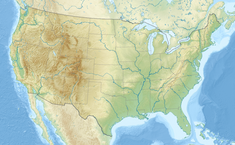| Glines Canyon Dam | |
|---|---|
 Glines Canyon Dam | |
| Location | On Elwha River, along Olympic Hot Springs Road, about 11 miles (18 km) southwest of Port Angeles, in Olympic National Park, Clallam County, Washington, USA |
| Coordinates | 48°00′07″N 123°36′00″W / 48.00203°N 123.59991°W |
| Construction began | 1925 |
| Opening date | 1927 |
| Demolition date | 2014 |
| Built by | Thebo, Starr, & Anderson Inc. |
| Designed by | P.M. Thebo; W.B. McMillan; W.A. Whitmire; H.R. Stevens; H. Schorer |
| Dam and spillways | |
| Impounds | Elwha River |
| Height | 210 ft (64 m) |
| Reservoir | |
| Creates | Lake Mills |
| Total capacity | 40,500 acre⋅ft (50,000,000 m3) |
| Surface area | 415 acres (168 ha) |
| Power Station | |
| Installed capacity | 13.3 MW[1] |
Glines Canyon Hydroelectric Power Plant | |
| Area | 7 acres (2.8 ha) |
| Architectural style | Classical Revival |
| MPS | Hydroelectric Power Plants in Washington State, 1890--1938 MPS |
| NRHP reference No. | 88002742[2] |
| Added to NRHP | December 15, 1988 |
Glines Canyon Dam, also known as Upper Elwha Dam,[3] was a 210-foot (64 m) tall concrete arch dam that impounded Lake Mills reservoir on the Elwha River in Clallam County, Washington. As of 2015[update], it is the tallest dam ever to be intentionally breached.
Built in 1927, Glines Canyon Dam was located 13 miles (21 km) upriver from the mouth of the Elwha River at the Strait of Juan de Fuca, and about 8 miles (13 km) upriver from Elwha Dam. Both dams lay within Olympic National Park, established in 1938. The National Park Service demolished Glines Canyon Dam in 2014 as part of the restoration of the Elwha River (Elwha Dam was demolished in 2011–2012). The project was the largest dam removal in history until the restoration of the lower Klamath River in the 2020s.
- ^ "Restoring Rivers: Major upcoming dam removals in the Pacific Northwest" (PDF). www.water.ca.gov. Archived from the original (PDF) on December 21, 2016. Retrieved June 21, 2016.
- ^ "National Register Information System". National Register of Historic Places. National Park Service. July 9, 2010.
- ^ U.S. Geological Survey Geographic Names Information System: Upper Elwha Dam

